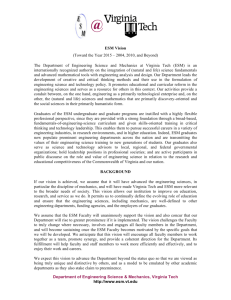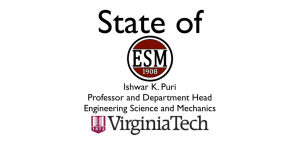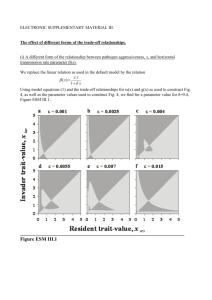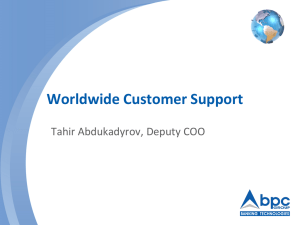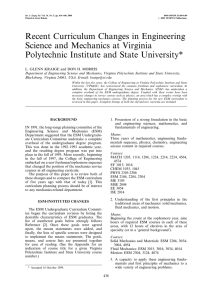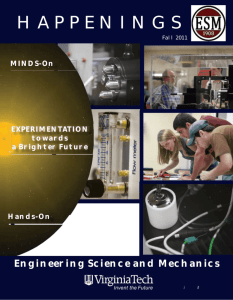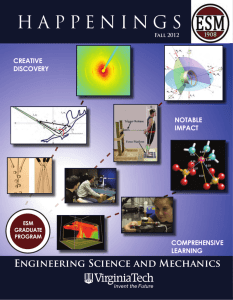Spring 2013
advertisement
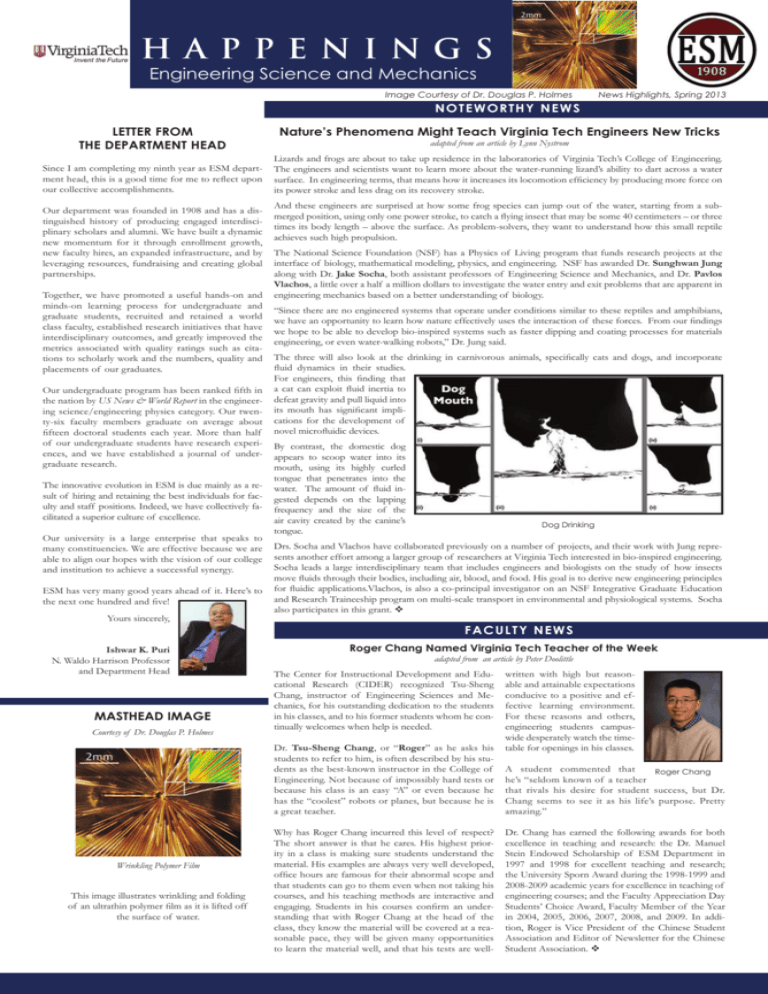
H A P P E N I NG S Engineering Science and Mechanics Image Courtesy of Dr. Douglas P. Holmes NO TE WORTHY NEWS LETTER FROM THE DEPARTMENT HEAD Since I am completing my ninth year as ESM department head, this is a good time for me to reflect upon our collective accomplishments. Our department was founded in 1908 and has a distinguished history of producing engaged interdisciplinary scholars and alumni. We have built a dynamic new momentum for it through enrollment growth, new faculty hires, an expanded infrastructure, and by leveraging resources, fundraising and creating global partnerships. Together, we have promoted a useful hands-on and minds-on learning process for undergraduate and graduate students, recruited and retained a world class faculty, established research initiatives that have interdisciplinary outcomes, and greatly improved the metrics associated with quality ratings such as citations to scholarly work and the numbers, quality and placements of our graduates. Our undergraduate program has been ranked fifth in the nation by US News & World Report in the engineering science/engineering physics category. Our twenty-six faculty members graduate on average about fifteen doctoral students each year. More than half of our undergraduate students have research experiences, and we have established a journal of undergraduate research. The innovative evolution in ESM is due mainly as a result of hiring and retaining the best individuals for faculty and staff positions. Indeed, we have collectively facilitated a superior culture of excellence. Our university is a large enterprise that speaks to many constituencies. We are effective because we are able to align our hopes with the vision of our college and institution to achieve a successful synergy. ESM has very many good years ahead of it. Here’s to the next one hundred and five! Yours sincerely, Ishwar K. Puri N. Waldo Harrison Professor and Department Head MASTHEAD IMAGE Courtesy of Dr. Douglas P. Holmes Nature’s Phenomena Might Teach Virginia Tech Engineers New Tricks adapted from an article by Lynn Nystrom Lizards and frogs are about to take up residence in the laboratories of Virginia Tech’s College of Engineering. The engineers and scientists want to learn more about the water-running lizard’s ability to dart across a water surface. In engineering terms, that means how it increases its locomotion efficiency by producing more force on its power stroke and less drag on its recovery stroke. And these engineers are surprised at how some frog species can jump out of the water, starting from a submerged position, using only one power stroke, to catch a flying insect that may be some 40 centimeters – or three times its body length – above the surface. As problem-solvers, they want to understand how this small reptile achieves such high propulsion. The National Science Foundation (NSF) has a Physics of Living program that funds research projects at the interface of biology, mathematical modeling, physics, and engineering. NSF has awarded Dr. Sunghwan Jung along with Dr. Jake Socha, both assistant professors of Engineering Science and Mechanics, and Dr. Pavlos Vlachos, a little over a half a million dollars to investigate the water entry and exit problems that are apparent in engineering mechanics based on a better understanding of biology. “Since there are no engineered systems that operate under conditions similar to these reptiles and amphibians, we have an opportunity to learn how nature effectively uses the interaction of these forces. From our findings we hope to be able to develop bio-inspired systems such as faster dipping and coating processes for materials engineering, or even water-walking robots,” Dr. Jung said. The three will also look at the drinking in carnivorous animals, specifically cats and dogs, and incorporate fluid dynamics in their studies. For engineers, this finding that a cat can exploit fluid inertia to defeat gravity and pull liquid into its mouth has significant implications for the development of novel microfluidic devices. By contrast, the domestic dog appears to scoop water into its mouth, using its highly curled tongue that penetrates into the water. The amount of fluid ingested depends on the lapping frequency and the size of the air cavity created by the canine’s tongue. Dog Drinking Drs. Socha and Vlachos have collaborated previously on a number of projects, and their work with Jung represents another effort among a larger group of researchers at Virginia Tech interested in bio-inspired engineering. Socha leads a large interdisciplinary team that includes engineers and biologists on the study of how insects move fluids through their bodies, including air, blood, and food. His goal is to derive new engineering principles for fluidic applications.Vlachos, is also a co-principal investigator on an NSF Integrative Graduate Education and Research Traineeship program on multi-scale transport in environmental and physiological systems. Socha also participates in this grant. v F ACULTY NEWS Roger Chang Named Virginia Tech Teacher of the Week adapted from an article by Peter Doolittle The Center for Instructional Development and Educational Research (CIDER) recognized Tsu-Sheng Chang, instructor of Engineering Sciences and Mechanics, for his outstanding dedication to the students in his classes, and to his former students whom he continually welcomes when help is needed. Dr. Tsu-Sheng Chang, or “Roger” as he asks his students to refer to him, is often described by his students as the best-known instructor in the College of Engineering. Not because of impossibly hard tests or because his class is an easy “A” or even because he has the “coolest” robots or planes, but because he is a great teacher. Wrinkling Polymer Film This image illustrates wrinkling and folding of an ultrathin polymer film as it is lifted off the surface of water. News Highlights, Spring 2013 Why has Roger Chang incurred this level of respect? The short answer is that he cares. His highest priority in a class is making sure students understand the material. His examples are always very well developed, office hours are famous for their abnormal scope and that students can go to them even when not taking his courses, and his teaching methods are interactive and engaging. Students in his courses confirm an understanding that with Roger Chang at the head of the class, they know the material will be covered at a reasonable pace, they will be given many opportunities to learn the material well, and that his tests are well- written with high but reasonable and attainable expectations conducive to a positive and effective learning environment. For these reasons and others, engineering students campuswide desperately watch the timetable for openings in his classes. A student commented that Roger Chang he’s “seldom known of a teacher that rivals his desire for student success, but Dr. Chang seems to see it as his life’s purpose. Pretty amazing.” Dr. Chang has earned the following awards for both excellence in teaching and research: the Dr. Manuel Stein Endowed Scholarship of ESM Department in 1997 and 1998 for excellent teaching and research; the University Sporn Award during the 1998-1999 and 2008-2009 academic years for excellence in teaching of engineering courses; and the Faculty Appreciation Day Students’ Choice Award, Faculty Member of the Year in 2004, 2005, 2006, 2007, 2008, and 2009. In addition, Roger is Vice President of the Chinese Student Association and Editor of Newsletter for the Chinese Student Association. v Suvojit Ghosh, ESM Graduate Student, is Awarded the Liviu Librescu Memorial Scholarship Mr. Suvojit Ghosh, ESM graduate student, has been awarded the prestigious Liviu Librescu Memorial Scholarship in 2013. This scholarship was established to honor Dr. Liviu Librescu, former ESM professor, who perished on April 16, 2007 in service of his students. The recipients of this scholarship must be outstanding students conducting research in solid mechanics, fluid mechanics and dynamics. Since joining ESM in 2009, Suvojit has been conducting research in the Multiphysics Research Group (MuRG) under the guidance of Dr. Ishwar K. Puri, N. From left: Suvojit Ghosh, Dr. Muhammad Hajj Waldo Harrison Professor and Department Head of ESM. The topic of Suvojit’s dissertation is “Self-Assembly of Magnetic Nanoparticles: A tool for building at the Nanoscale.” ESM is very proud of Suvojit’s accomplishments. v ESM Student, Scinju Gadamsetty, Embodies Ut Prosim In the fall of 2012, Scinju Gadamsetty of Fairfax, Va., a senior in the Department of Engineering Science and Mechanics and a member of the Corps of Cadets, decided that his friend Justin Graves, a master’s student in the Department of Educational Leadership & Policy Studies, needed to see the Cascade Falls – a hike that is a Hokie tradition. However, the hike seemed impossible to Graves, a paraplegic who has been reliant on a wheelchair since age 3. ALUMNI NEWS Mehran Tehrani and Masoud Safdari receive NSF Sponsored Travel Award for the 2012 ASME International Mechanical Engineering Conference and Exposition Mehran Tehrani and Masoud Safdari, both former PhD students in ESM, were awarded two National Science Foundation (NSF) Travel Grants to attend the ASME – IMECE 2012, Houston, TX. The annual ASME-IMECE is the premier global conference for mechanical engineers. In 2012, 40 students out of 342 applicants were selected for the travel awards. The award recognizes skilled engineering workforce and provides financial support for the grantee to attend the ASME annual conference. Masoud Safdari Mehran Tehrani Masoud Safdari and Mehran Tehrani were both working under supervision of ESM Professor Marwan Al-Haik. Masoud completed his Ph.D research on the theoretical and experimental investigations of the transport properties of hybrid polymeric nanocomposite based on carbon nanotubes and graphite nanoplatelets. He also received one of the The American Society for Composites (ASC) scholarships in 2012. Mehran Tehrani who passed his final PhD defense and is working on next generation multifunctional composites for impact, vibration and electromagnetic radiation hazards mitigation. Both students presented their research at the NSF Sponsored Student Poster Symposium on November 14, at the ASME-IMECE 2012. v ESM Alumnus Ganesh Balasubramanian Joins Iowa State University MuRG alumnus Ganesh Balasubramanian has joined Iowa State University as assistant professor of mechanical engineering. At Virgnia Tech, his research involved molecular simulations of nanoscale Ganesh Gadamsetty thought From left: Scinju Gadamsetty, ransport that have lead to a better Balasubramanian Justin Graves that the ultimate Hokie understanding of themochemical energy storage systems, needed to see the wathermoelectric behavior, elastomeric proteins, and the role terfall at the Cascades in nearby Giles County, Va. So in of interfacial thermal resistance during heat transfer across the spirit of Virginia Tech’s motto Ut Prosim (That I May dissimilar materials. Serve), Gadamsetty rounded up a group of Hokies to take Graves to the falls. After completing his doctorate in 2011, Dr. Balasubramanian was a postdoctoral researcher at Technische UnversiMore than a dozen Hokies joined in the quest taking turns tat Darmstadt in Germany. At Iowa State, he is establishcarrying Graves by either a makeshift stretcher that Graves ing a research program centered on multiscale effects on could sit upon, or by back. To ensure that Graves captured the mechanical properties of materials and related energy the full extent of the hike, the student group opted to take related applications. v him along a more difficult, steep climb. What Do ESM Graduates Do? “The hike went great,” Graves would write the next day on his personal blog. “I was so proud, as I got to enjoy the beautiful scenery of this 2 mile (one-way) hike, that I had friends that were willing to not only take a TON of time out of their day … but to give me their bodies and energy to get me to the top of a mountain. How much more Ut Prosim can you get then carrying a man to the top of a mountain? ”v Professor Mary C. Boyce (ESM BS ‘81) is the Ford Professor of Engineering and Department Head of Mechanical Engineering at the Massachusetts Institute of Technology. Mary Boyce Dr. Boyce earned her B.S. degree in Engineering Science and Mechanics from Virginia Tech; and her S.M. ALUMNI NEWS ( C O N TI N UE D ) and Ph.D. degrees in Mechanical Engineering from the Massachusetts Institute of Technology. She joined the M.I.T. faculty in 1987. Dr. Boyce teaches in the areas of mechanics and materials. Her research areas focus primarily on the mechanics of elastomers, polymers, polymeric-based micro- and nano-composite materials, lattice- structured materials, natural materials, and biological macromolecular networks, with emphasis on identifying connections among microstructure, deformation mechanisms, and mechanical properties. Dr. Boyce has been the recipient of several awards and honors recognizing her research and teaching efforts, including the MIT MacVicar Faculty Fellow, the Department of Mechanical Engineering Keenan Award for Teaching, the Spira Award for Teaching, the NSF Presidential Young Investigator Award, the ASME Applied Mechanics Young Investigator Award, Memberat-Large of the USNCTAM, Chair of the ASME Applied Mechanics Division, Fellow of the American Academy of Mechanics, Fellow of the ASME, Fellow of the American Academy of Arts and Sciences, and Member of the National Academy of Engineering. As an ESM graduate, you also can be an internationally recognized professor and scientist, and become the head of a leading department some day.v ESM Alumnus Maurizio Porfiri Wins Gary Anderson Award Maurizio Porfiri (Ph.D., 2006) has been selected as the winner of the 2012 Gary Anderson Early Achievement Award for his contributions to the field of smart structures and materials. The prize is awarded to a young researcher in his or her ascendancy whose work has already had an impact in his/her field within Adaptive Structures and Material Systems. You may recall that MaruMaurizio Porfiri zio was named VT CoE’s Distinguished Young Alumnus, and Popular Science named him as one of the 10 Brilliant Scientists in 2010. v E D I T O RI A L BO A RD Ishwar K. Puri, Publisher Anne-Marie Bracken, Editor Christine B. Burgoyne, Layout Design We want to hear from you! Please forward your comments, suggestions, and story ideas to: Anne-Marie Bracken ESM Department 221 Norris Hall, Virginia Tech Mail code: 0219 Blacksburg, VA 24061 Phone: 540-231-3243 Email: brackena@vt.edu Virginia Tech does not discriminate against employees, students, or applicants on the basis of race, sex, handicap, age, veteran status, national origin, religion, or political affiliation. Anyone having questions concerning discrimination should contact the Equal Opportunity/ Affirmative Action Office. Dr. Ishwar K. Puri N. Waldo Harrison Professor and Department Head Engineering Science and Mechanics Virginia Tech Blacksburg, VA 24061 http://www.esm.vt.edu S T U DE NT N E W S Non Profit Org. U.S. Postage PAID Blacksburg, VA 24060 Permit #28
